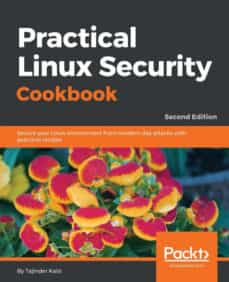[Kindle] PRACTICAL LINUX SECURITY COOKBOOK:
PRACTICAL LINUX SECURITY COOKBOOK: SECURE YOUR LINUX ENVIRONMENT FROM MODERN-DAY ATTACKS WITH PRACTICAL RECIPES (2ND EDITION) de TAJINDER KALSI-
Ficha técnica
- PRACTICAL LINUX SECURITY COOKBOOK: SECURE YOUR LINUX ENVIRONMENT FROM MODERN-DAY ATTACKS WITH PRACTICAL RECIPES (2ND EDITION)
- TAJINDER KALSI-
- Número de páginas: 482
- Idioma: INGLÉS
- Formatos: Pdf, ePub, MOBI, FB2
- ISBN: 9781789138399
- Editorial: PACKT PUBLISHING
- Año de edición: 2018
Descargas de libros electrónicos pdf PRACTICAL LINUX SECURITY COOKBOOK: SECURE YOUR LINUX ENVIRONMENT FROM MODERN-DAY ATTACKS WITH PRACTICAL RECIPES (2ND EDITION) (Literatura española) de TAJINDER KALSI-
Overview
Enhance file system security and learn about network attack, security tools and different versions of Linux build. Key Features Hands-on recipes to create and administer a secure Linux system Enhance file system security and local and remote user authentication Use various security tools and different versions of Linux for different tasks Book DescriptionOver the last few years, system security has gained a lot of momentum and software professionals are focusing heavily on it. Linux is often treated as a highly secure operating system. However, the reality is that Linux has its share of security flaws, and these security flaws allow attackers to get into your system and modify or even destroy your important data. But there's no need to panic, since there are various mechanisms by which these flaws can be removed, and this book will help you learn about different types of Linux security to create a more secure Linux system. With a step-by-step recipe approach, the book starts by introducing you to various threats to Linux systems. Then, this book will walk you through customizing the Linux kernel and securing local files. Next, you will move on to managing user authentication both locally and remotely and mitigating network attacks. Later, you will learn about application security and kernel vulnerabilities. You will also learn about patching Bash vulnerability, packet filtering, handling incidents, and monitoring system logs. Finally, you will learn about auditing using system services and performing vulnerability scanning on Linux. By the end of this book, you will be able to secure your Linux systems and create a robust environment. What you will learn Learn about vulnerabilities and exploits in relation to Linux systems Configure and build a secure kernel and test it Learn about file permissions and how to securely modify files Authenticate users remotely and securely copy files on remote systems Review different network security methods and tools Perform vulnerability scanning on Linux machines using tools Learn about malware scanning and read through logs Who this book is forThis book is intended for all those Linux users who already have knowledge of Linux file systems and administration. You should be familiar with basic Linux commands. Understanding information security and its risks to a Linux system is also helpful in understanding the recipes more easily.


0コメント